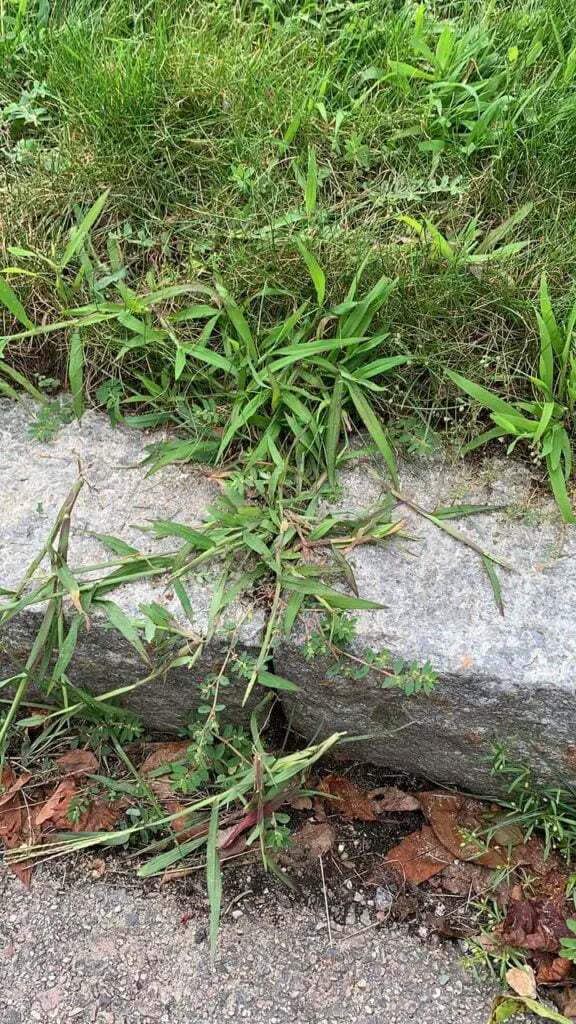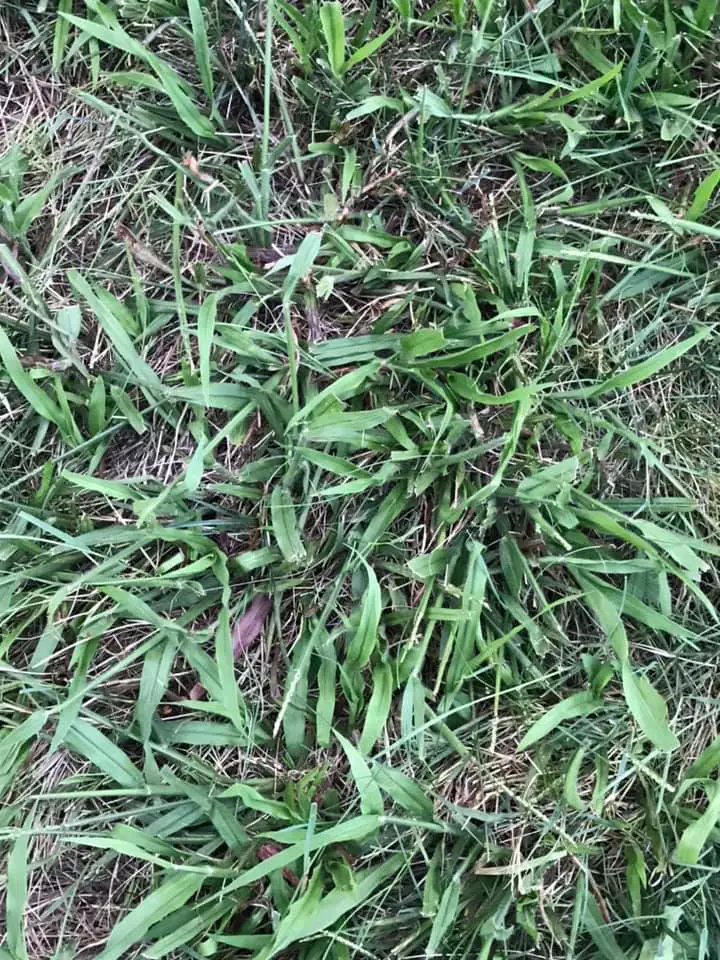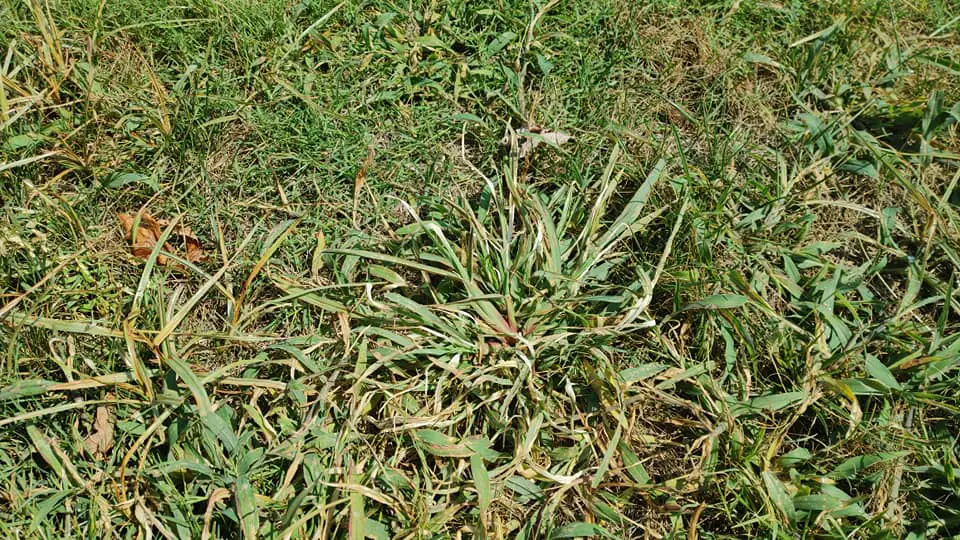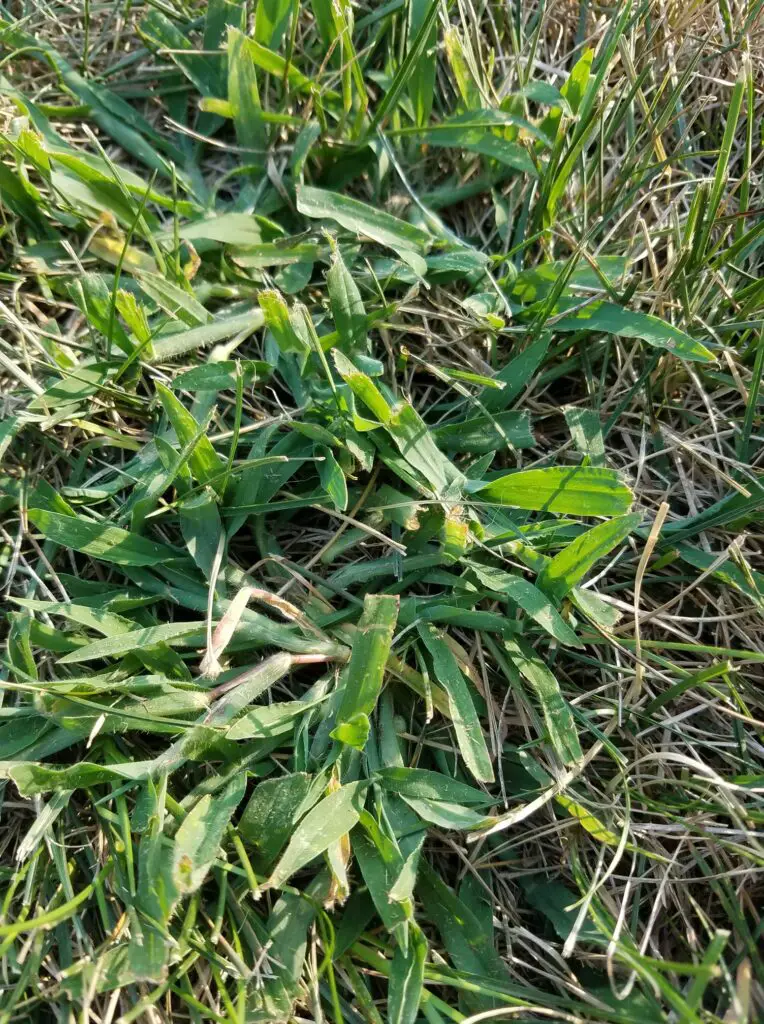Applying a crabgrass preventer is one of the first steps in any lawn care plan. Crabgrass is a widespread lawn weed and one of the most invasive lawn weeds, too. Without a pre-emergent herbicide and prevention strategy, this grassy annual weed can take over an entire lawn in no time. We’ll discuss the best crabgrass control program for your cool-season lawn and answer the question of “when to apply a crabgrass preventer?”.
Table of Contents
When Should I Apply Crabgrass Preventer?
Apply your first round of crabgrass preventer (also called pre-emergent herbicide) in the early spring before the soil temperature reaches 55 degrees Fahrenheit (12 Celcius) to control crabgrass, henbit, chickweed, poa annua, and other common lawn weeds. For best results, apply a second application of pre-emergent in the early summer – or about 8 weeks later – when soil temps hit 65-70 degrees Fahrenheit (18-21 degrees Celcius).
Be sure to read the labels of each herbicide, as there will be a maximum annual amount you can apply in a calendar year. For example, the maximum application rate per year for 0-0-7 with 0.37% Prodiamine Herbicide is between 4.0 and 9.3 pounds per 1,000 square feet, depending on the grass type.
Crabgrass Preventer Schedule for Cool-Season Lawns
| CRABGRASS PREVENTER | AMOUNT PER 1,000 sq. ft. | TIMING | SOIL TEMPS |
| 0-0-7 with 0.37% Prodiamine | 5 lbs. | Early Spring | 50-55 |
| 21-0-10 with 0.25% Dimension | 4 lbs. | Early Summer | 65-70 |
The table above is the same program I use on my personal yard and the lawns of my clients.
- Early spring (early April) is too early to apply Nitrogen, especially if you spread a winter fertilizer the year prior – apply Prodiamine 0-0-7
- Dimension contains some post-emergent qualities and can act as a post-emergent crabgrass killer, particularly on younger crabgrass in the first 1-2 tiller stages
- A combo fertilizer (21% nitrogen + pre-emergent) is perfect timing to feed your lawn
- The 10% Potassium can help with the stresses of the hotter summer months ahead
Crabgrass Preventer Schedule for Cool-Season Lawns (Not Overseeding – Poa Annua control)
| CABGRASS PREVENTER | AMOUNT PER 1,000 sq. ft. | TIMING | SOIL TEMPS |
| 0-0-7 with 0.37% Prodiamine | 4 lbs. | Early Spring | 50-55F |
| 21-0-10 with 0.25% Dimension | 4 lbs. | Early Summer | 65-70F |
| 0-0-7 with 0.37% Prodiamine | 5 lbs. | Late Summer | CRABGRASS PREVENTER |
The table above is a good crabgrass preventer schedule for those looking to control Poa Annua (annual bluegrass) and not fall overseeding. These crabgrass pre-emergent herbicides will affect not only your targeted weeds but also the seed germination of your good grass. So you cannot use any of these weed preventers while seeding or overseeding.
Another option in place of Prodimaine in late summer (late August/early September) is Pendulum 2G at 0.5 lb. per 1,000 square feet.
Soil Temperatures
The key to stopping crabgrass seeds from emerging is timing the soil temperatures. The temperature of the soil – not outside air temps) dictate when the crabgrass seeds germinate.
The first soil temperature to check is when the ground approaches 55 degrees Fahrenheit (11-12 degrees Celcius). The second is a soil temp range of 65-70 degrees Fahrenheit (18-23 degrees Celcius). These ground temperature ranges can span over the course of 3-4 months.
A crabgrass seed can be in the soil near a sidewalk or driveway where the ground heats up much quicker, and the seed germinates much sooner. Whereas another crabgrass seed might be in the middle of a shaded area, and not warm up and germinate until much later. This is why we always use a split application of crabgrass preventer to control crabgrass.
Crabgrass Preventers (How Pre-Emergents Work)
The most common and effective crabgrass pre-emergent herbicides are Prodiamine (Barricade), Dithiopyr (Dimension), and Pendimethalin (Halts). For this article, we will continue to focus on the most popular Group 3 herbicides: Prodiamine and Dithiopyr.
Both crabgrass preventers are considered Root & Shoot Inhibitors. A vapor barrier is formed in the soil layer that prevents the weeds from emerging while inhibiting the root system from developing. The undeveloped roots cannot take up water or nutrients and thus die off.
Note these pre-emergent herbicides do not prevent the crabgrass seeds from germinating but rather inhibit the plant’s cell division at the root zone and prevent the crabgrass seedlings from growing and emerging. They are coined as root pruning herbicides or root clubbers.
Granular products are spread over the lawn using a fertilizer spreader, and the liquid versions of these pre-emergents (or Wettable Dispersible Granule) are sprayed evenly over the turf with a backpack sprayer or two-behind sprayer.
Prodiamine vs. Dithipoyr
- Prodiamine is generally less expensive than Dithiopyrn (Dimension)
- Prodimaine is longer lasting – can withstand excess irrigation and rainfall
- Prodiamine is better applied early in the season – Dimension later in the season
Another popular AI is Mesotrione. The most well-known Mesotrione product is Tenacity herbicide, and the generic Meso 4SC. Scott’s Starter Fertilizer with weed preventer also contains Mesotrione. If you are seeding in the spring, apply one of these pre-emergent herbicide products as it’s the only chemical that can be used as a pre-emergent without affecting the germination of your good grass. It lasts about 30 days.
If you are not seeding, stick to the previous three options above as you will get much longer efficacy and coverage.
Crabgrass Lifecycle
Crabgrass seeds start to germinate in the early spring as soil temperatures reach 55 degrees Fahrenheit for 2-3 consecutive days. However, as we previously mentioned, the germination window can span from early spring and into the early summer months when soil temperatures are optimal.
The crabgrass does not grow in full shade, but rather thrives in the sun and hot summer months. This grassy weed likes open areas – so any bare spots in your lawn will soon be occupied by crabgrass.
Crabgrass sheds thousands of seeds and, without prevention, multiplies rapidly each year. It can quickly outgrow and choke out your good grass – robbing it of sun, water, and nutrients – and completely take over your lawn.
At the end of the season, the crabgrass dies off while the crabgrass seeds remain in the soil over winter, only to begin the germination and growing cycle again the following spring and summer.
That is why it is very important to apply a crabgrass pre-emergent before the seeds germinate. It’s best to prevent crabgrass before these pesky weeds mature. For post-emergent crabgrass killers, read how to get rid of crabgrass and the best crabgrass killers.
Crabgrass Identification
Crabgrass (large and smooth crabgrass) is a grassy and annual weed. These are different from broadleaf weeds and biennial and perennial weeds. Younger tiller stages of crabgrass will be a lighter green and turn darker as it matures. Some crabgrass species can also take on a purple color.
The crabgrass grass blades have a pointed spade tip and can have white fuzz. As it matures, it will begin to go to seed. As the seed heads grow, four seed heads will be in a bunch. – like a fan.
Crabgrass can be mistaken for other grasses and weeds, particularly if you have a patchy lawn – clumping tall fescue, creeping bentgrass, poa trivialis, etc.
Crabgrass grows from a central vine and branches outward from the center. It grows low and parallel to the ground in a star-like shape and begins to take on the appearance of crab legs as it matures (hence the name “crabgrass”).
Crabgrass Pictures





Crabgrass Preventer FAQs
Should I water after applying a crabgrass preventer?
Yes, both prodiamine and dithiopyr need to be watered in and moved into the soil to activate and form the vapor barrier.
Can I apply crabgrass preventer twice?
Yes, a split application of crabgrass preventer is the best strategy. Apply crabgrass pre-emergent (prodiamine) in the early spring and another round (dithiopyr) in the early summer for season-long coverage.
Can you apply too much crabgrass preventer?
Yes, there are maximum annual rates on these Group 3 herbicides. Crabgrass preventers are root pruning and inhibit root growth, and over-applying can affect the roots or your good grass.
Can you apply Scott’s crabgrass preventer on wet grass?
It’s best to apply to dry grass blades. However, if the turf is wet or damp, be sure to water the product in immediately after spreading.
Should I apply crabgrass preventer before or after rain?
You can apply crabgrass preventer before the rain so the product is watered into the soil and activated. However, excessive rainfall or torrential downpours could wash the herbicide away.

What is the best crabgrass pre-emergent to use for Springfield, IL? Can you please recommend?
Hi Julia! For your first application, I highly recommend Prodiamine/Barricade. Do you prefer to use granular or liquid?
When should I apply granular in Akron OH this year?
Hi Rich. Based on your area and historical soil temps, I’d target by the end of March or first week of April. Soil temps this year are warmer so I’d go with Prodiamine sooner than later.
I put first application in the early spring it rained a little, will this be ok? How can you tell if carb grass is dying?
Hi Patricia. Rain is good. You need to water these products in to activate anyways. Depending on what you applied, these products won’t kill germinated and established crabgrass (aside from liquid Dimension at max rates). Depending on the post emergent herbicide, the plant will start to turn white (if you use Tenacity) or purple/brown (when you use Quinclorac). Hope this helps!